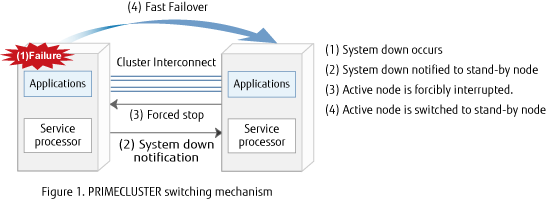Archived content
NOTE: this is an archived page and the content is likely to be out of date.
PRIMECLUSTER Introduction
- The Answer for Business Continuity -
Clustering SPARC Enterprise servers using Fujitsu PRIMECLUSTER will dramatically improve system uptime. Even if one server stops all together, system continuity is maintained by the forcible switching of operations from the operational server onto its backup twin.
Fail-Safe Switching Even When Server Stops
Early detection and very fast switching
Early problem detection is the first lesson in maximizing system uptime.
By inter-working with the server hardware, PRIMECLUSTER can swiftly detect any failure and fast switch the applications to an alternative server.
All Fujitsu servers contain, as standard, dedicated and independent hardware monitoring processors. This means that even if a server hangs, the monitoring processors keep operating and assist the system administrator to diagnose the problem. In the meantime the necessary system recovery operation quickly continues in the background.
By inter-working with all these high availability mechanisms(1) PRIMECLUSTER can immediately detect the system hang and forcibly switch affected applications to the alternative server. (Figure 1. "PRIMECLUSTER switching mechanism")
(note 1)
- SPARC Enterprise M-series Extended System Control Facility(XSCF)
- SPARC Enterprise T-series Integrated Light Out Manager (ILOM)

Failure prevention during switching
To assure any server switchover is successful, PRIMECLUSTER regularly checks the disk and server hardware. This prevents unintended failure during switching.
High-Efficiency Cluster
PRIMECLUSTER can increase the server utilization within the cluster system.
PRIMECLUSTER can reduce switching time by only switching the minimum number of failed applications and their environment to the alternate node. When a failure occurs, this is much faster than switching the whole server node. The PRIMECLUSTER approach means customers do not need idle system resources that are only used following a failure.
High availability and efficiency
A mutual stand-by cluster is one method of achieving such cost-efficient benefits (Figure 2. “Mutual stand by cluster system”).
- Under normal server status, applications run on both servers. Cluster application A runs on node 1, and cluster application B runs on node 2.
- If application A fails, switching occurs. Then in node 2, cluster application A is transformed to active status.



